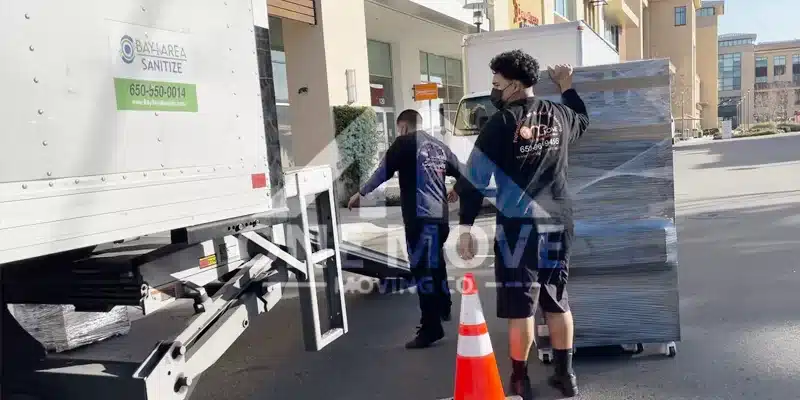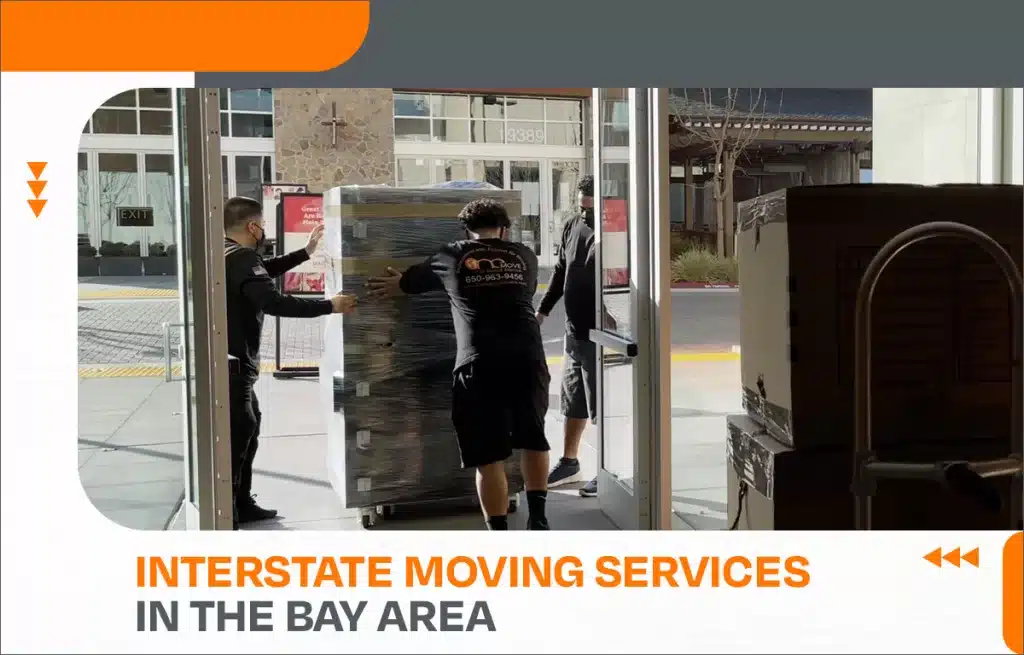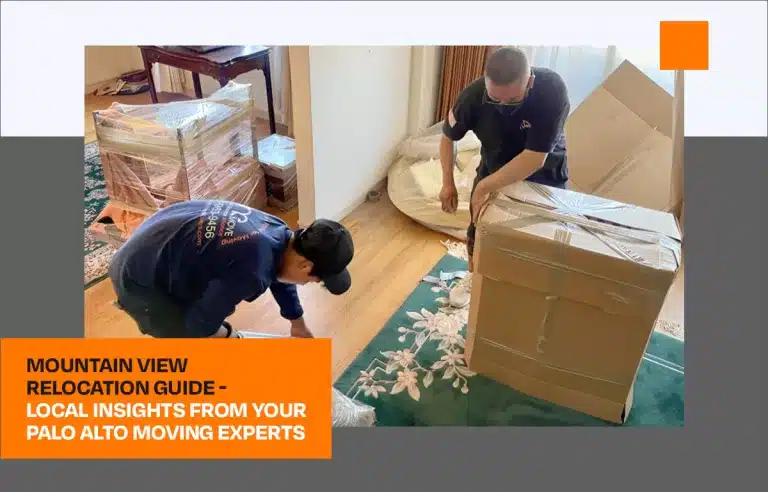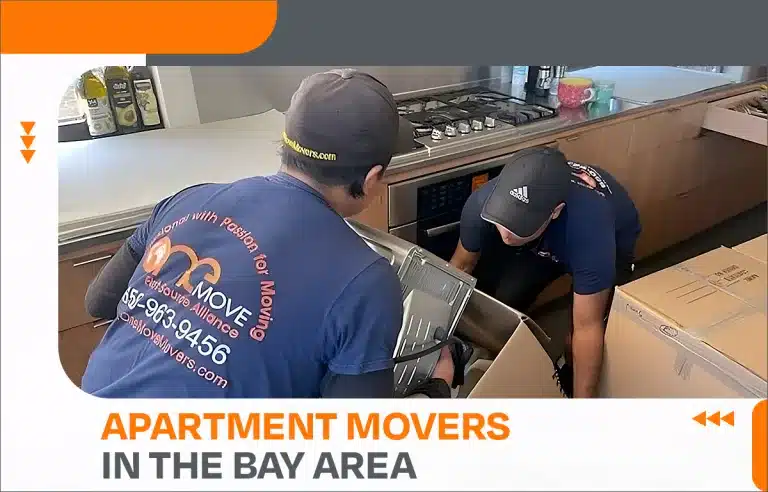Understanding Interstate Moving from the Bay Area’s Unique Perspective
Interstate relocations from Silicon Valley present distinct challenges and considerations unlike those found in any other region. The combination of the Bay Area’s high-value homes, technology-focused households, and California’s specific regulations creates a moving landscape that requires specialized knowledge and approach. As experienced movers based in Palo Alto serving Mountain View, Menlo Park, and surrounding communities, we’ve helped thousands of clients successfully navigate cross-country transitions while protecting their investments and ensuring smooth transitions.
Whether you’re relocating for career opportunities, family needs, or lifestyle changes, moving from the Bay Area to another state involves complex logistics, careful planning, and strategic decision-making. This comprehensive guide addresses the questions and concerns we consistently see from local residents planning interstate moves, providing practical guidance for navigating this significant life transition.
The Interstate Moving Process: Timeline and Planning
Optimal Planning Timeframes for Bay Area Departures
Successful interstate relocations from Palo Alto and surrounding areas require more extensive preparation than local moves:
- 3-4 Months Before: Initial research and moving company evaluation
- 2-3 Months Before: In-home or virtual surveys from selected companies
- 6-8 Weeks Before: Booking your preferred interstate mover
- 4-6 Weeks Before: Beginning systematic downsizing and organization
- 2-4 Weeks Before: Starting non-essential packing
- 1-2 Weeks Before: Finalizing logistics and preparing essential documents
According to discussions on Bay Area moving forums, those who begin planning at least three months in advance report significantly less stress and more favorable rates than those with compressed timelines.
Seasonal Considerations for Interstate Departures
The timing of your interstate move significantly impacts both cost and experience:
- Summer (June-August): Peak season with highest demand and rates
- Fall (September-November): Favorable weather with moderate demand
- Winter (December-February): Lowest rates but weather considerations
- Spring (March-May): Increasing availability with moderate rates
Silicon Valley’s mild climate allows for year-round moving, but your destination’s seasonal conditions must factor into planning. Online discussions from Bay Area residents highlight that winter moves to snow-prone states require additional contingency planning, while summer moves can face extreme heat in many destinations.
Understanding Interstate Moving Regulations
Cross-state moves involve specific regulatory frameworks:
- Federal Motor Carrier Safety Administration (FMCSA) oversight
- Department of Transportation (DOT) registration requirements
- Interstate operating authority (MC number) verification
- California-specific regulations for departing moves
- Destination state requirements and regulations
Comparing Interstate Moving Options from the Bay Area
Full-Service Interstate Moving Companies
Comprehensive moving services offer complete relocation solutions:
- Professional packing and unpacking services
- Loading, transportation, and unloading
- Furniture disassembly and reassembly
- Appliance disconnection and reconnection
- Specialty item handling and crating
Hybrid Moving Approaches
Many Bay Area residents opt for combined approaches:
- Self-packing with professional transportation
- Container services with flexible loading timeframes
- Partial moving services for specific areas or items
- Labor-only assistance at origin and destination
- Consolidated shipping options for smaller households
DIY Interstate Moving Considerations
Self-managed moves present specific challenges from the Bay Area:
- Long-distance truck rental limitations
- One-way rental premiums from California locations
- Fuel costs across multiple states
- Mountain driving considerations on major routes
- Extended travel time requirements
Understanding Interstate Moving Costs from the Bay Area
Primary Cost Factors for Long-Distance Relocations
Several variables influence interstate moving expenses:
- Distance to destination: Primary cost determinant
- Household size and volume: Weight or cubic footage
- Service level selected: From full-service to basic transportation
- Specialty items requiring special handling
- Access challenges at origin or destination
- Seasonal timing and demand fluctuations
Average Cost Ranges for Interstate Moves
Based on current market analysis and online discussions from Bay Area residents:
- Studio/1-Bedroom: $3,500-$6,000 for interstate moves
- 2-3 Bedroom Home: $6,000-$12,000 for typical interstate relocations
- 4+ Bedroom Home: $12,000-$20,000+ for larger households
These figures reflect full-service moving from Palo Alto and surrounding areas to popular out-of-state destinations. Costs vary significantly based on specific origin/destination combinations and service levels selected.
Hidden Costs to Anticipate
Online forums reveal several unexpected expenses Bay Area residents encounter:
- Shuttle service for limited access locations
- Long carry charges at origin or destination
- Storage-in-transit if housing dates don’t align
- Specialty packing materials for high-value items
- Insurance coverage beyond basic valuation
- Destination state’s higher (or lower) cost of living
Popular Interstate Destinations from the Bay Area
Top Relocation States for Bay Area Residents
Current migration patterns show these frequent destinations:
- Washington State: Particularly Seattle and Bellevue for tech opportunities
- Texas: Austin, Dallas, and Houston for technology and business hubs
- Colorado: Denver and Boulder for lifestyle and emerging tech scenes
- Arizona: Phoenix and Scottsdale for retirement and lifestyle changes
- Nevada: Reno and Las Vegas for proximity and tax advantages
- Oregon: Portland and Bend for cultural similarity and outdoor lifestyle
Each destination presents specific moving considerations regarding distance, regulations, and logistical planning from the Bay Area.
Route-Specific Considerations
Major interstate routes from the Bay Area present unique challenges:
- I-5 North: Mountain passes to Pacific Northwest destinations
- I-80 East: Sierra Nevada crossing and variable weather conditions
- I-5 South/I-10 East: Desert heat considerations to Southwest destinations
- I-80/I-70 Combination: Mountain driving to Colorado and Midwest locations
- I-5/I-84 Route: Alternative northern route with varied terrain
Protecting Your Belongings During Interstate Moves
Valuation and Insurance Options
Online discussions emphasize the importance of understanding protection options:
- Basic Released Value Protection: Minimal coverage at $0.60 per pound
- Full Value Protection: Coverage at $6 per pound with various deductible
- Third-Party Moving Insurance: Various coverage options through insurance providers
- Specialized Coverage: For high-value electronics, artwork, and collectibles
- Homeowners Insurance Considerations: Possible coverage during transit
High-Value Item Considerations
Silicon Valley households often include significant technology and valuable items:
- Fine Art and Collectibles: Custom crating and specialized handling
- Wine Collections: Temperature-controlled transportation
- Tech Equipment and Home Electronics: Specialized packing protocols
- Musical Instruments: Climate-controlled options and custom crating
- Luxury Furniture and Heirlooms: Premium protection systems
Managing Interstate Moving Day from the Bay Area
Pre-Move Preparation Essentials
Proper preparation ensures smoother interstate departures:
- Comprehensive labeling systems with destination rooms
- Detailed inventory documentation with condition notes
- Essential items box preparation for immediate needs
- First night box with bedding and personal necessities
- Technology protection and data backup implementation
Interstate Moving Day Protocols
The day of an interstate move requires specific attention:
- Walk-through procedures with move supervisor
- Inventory verification and condition documentation
- High-value item verification processes
- Estimated delivery window confirmation
- Communication protocol establishment for transit period
Special Considerations for Bay Area Interstate Moves
Technology Industry Relocations
Silicon Valley’s tech focus creates specialized moving needs:
- Home Office and Technology Equipment: Specialized packing and protection
- Data Security During Transitions: Secure transportation of sensitive information
- Remote Work Continuity Planning: Minimizing disruption to work capabilities
- Technology-Ready Home Considerations: Connectivity at destination
- Corporate Relocation Policy Navigation: Understanding employer benefits
Housing Transition Strategies
The Bay Area’s unique real estate market affects interstate moving timelines:
- Selling in a High-Value Market: Timing considerations and strategy
- Rent-Back Options: Allowing flexibility after home sale
- Temporary Housing Considerations: During transition periods
- Property Management Options: For those retaining Bay Area properties
- Housing Market Differences: Adjusting to different real estate environments
Storage Options During Interstate Transitions
Storage-in-Transit Services
Timing gaps often necessitate temporary storage:
- Short-Term Options During Transition: 30-90 day solutions
- Climate-Controlled Storage Considerations: For sensitive items
- Security Factors for Extended Storage: Protection systems
- Accessibility Options During Storage Periods: Retrieval needs
- Cost Structure for Various Storage Durations: Budget planning
Long-Term Storage Strategies
Some interstate moves involve extended storage needs:
- Vaulted Storage Systems: For maximum protection
- Inventory Management for Extended Periods: Organization systems
- Insurance Considerations for Long-Term Storage: Ongoing protection
- Periodic Inspection Options: Ensuring condition maintenance
- Destination vs. Origin Storage Considerations: Strategic placement

Frequently Asked Questions About Interstate Moving from the Bay Area
Interstate Moving Logistics
Q: How long does it typically take for my belongings to arrive when moving from Palo Alto to the East Coast?
A: Transit times from Palo Alto and surrounding Bay Area cities to the East Coast typically range from 7-14 days for direct transport services. This timeline depends on several factors including:
- Specific origin and destination locations
- Whether your shipment is direct or consolidated with others
- Seasonal traffic and weather conditions
- Required rest periods for drivers under federal regulations
- Any storage-in-transit requirements
Most reputable interstate movers provide a delivery window rather than a specific date, with narrower windows provided as your delivery approaches.
Q: Should I fly or drive to my new state when moving from the Bay Area?
A: This common question on moving forums has multiple considerations:
- For destinations beyond 1,500 miles, most Bay Area residents report preferring to fly and have their vehicles shipped
- For medium-distance moves (500-1,500 miles), preferences split between driving and flying
- Those relocating with pets frequently choose driving for animal comfort
- Families with children often prefer flying to minimize travel stress
- Those viewing the move as a transitional adventure often drive to experience the journey
Cost comparisons should include fuel, accommodations, meals, and time value versus airfare and vehicle shipping expenses.
Q: How can I transport my plants interstate from California?
A: Plant transportation from California faces specific challenges due to agricultural restrictions:
- Many states have restrictions on bringing in California plants due to pest concerns
- The USDA provides state-by-state regulation information
- Professional movers generally won’t transport plants on interstate moves
- For cherished plants, consider taking cuttings in sealed containers
- For destinations with compatible growing conditions, shipping dormant plants through specialized plant shipping services is an option
According to gardening forums, success rates for relocating established plants cross-country are low, and many Bay Area residents recommend gifting plants locally and purchasing new ones at the destination.
Cost and Budgeting Questions
Q: How can I reduce costs on an interstate move from the expensive Bay Area?
A: Cost-saving strategies frequently discussed by Bay Area residents include:
- Moving during off-peak seasons (October-April)
- Significant decluttering to reduce volume (especially important when downsizing from California’s high square footage costs)
- Handling packing yourself while hiring professionals for transportation
- Obtaining multiple quotes from competing companies
- Flexible delivery windows allowing for consolidated shipments
- Exploring tax deductions for qualifying moving expenses
- Negotiating employer relocation benefits when applicable
Many Bay Area residents report saving 25-40% by implementing these strategies for their interstate moves.
Q: Are there tax benefits for moving out of California?
A: This frequent question has several components:
- Federal tax deductions for moving expenses are currently limited to active-duty military
- Some employers offer tax-advantaged relocation benefits
- State tax implications vary significantly depending on destination state
- Property tax differences between California and destination states can be substantial
- Consulting with a tax professional about state-specific implications is advisable
Many forums discuss the significant tax differences between California and states like Texas, Nevada, or Washington, which can offset moving costs over time.
Logistics and Planning
Q: How do I handle moving a vehicle from the Bay Area to another state?
A: Vehicle transportation options include:
- Professional auto transport services (open or enclosed carriers)
- Drive-away services where someone drives your vehicle
- DIY driving, either alongside the moving truck or separately
- Towing behind a rental truck or personal vehicle
Auto transport from the Bay Area typically costs $1,000-$2,500 depending on destination and vehicle size. Online discussions note that enclosed transport, while more expensive, is recommended for luxury vehicles common in Silicon Valley.
Q: What’s the best way to move with pets from California to another state?
A: Pet relocation considerations include:
- Veterinary visits before moving to ensure health certificates and vaccination records
- State-specific entry requirements for animals
- Air travel vs. road travel considerations based on pet temperament
- Temporary accommodations that accept pets during transition
- Microchipping and tag updates prior to moving
Bay Area pet owners frequently recommend maintaining a consistent routine for animals during the chaotic moving period and keeping familiar items accessible throughout the transition.
Interstate Moving from Specific Bay Area Communities
Palo Alto Interstate Moving Considerations
Our Palo Alto-based insights include:
- High-Value Home Considerations: Protecting significant investments
- Academic Calendar Timing: For university-affiliated households
- Tech-Centric Household Needs: Specialized equipment handling
- Historic Home Moving Protocols: For older Palo Alto properties
- Executive Relocation Services: For corporate transitions
Mountain View and Sunnyvale Departures
These technology-focused communities present:
- Tech Campus-Adjacent Properties: Access considerations
- Apartment and Condo-Heavy Moves: Building regulations
- International Workforce Considerations: Coordinating with global transitions
- Startup Relocation Needs: Flexible scaling options
- Technology Equipment Concentration: Specialized protection requirements
Menlo Park and Atherton Relocations
These premium communities require:
- High-Value Estate Moving Expertise: Comprehensive services
- Art and Valuable Collection Transportation: Specialized handling
- Luxury Home Specific Approaches: Premium protection systems
- Privacy and Security Priorities: Confidential moving services
- White-Glove Service Expectations: Executive-level attention
Preparing Your Bay Area Home for Departure
Pre-Move Home Organization Strategies
Systematic approaches for efficient interstate departures:
- Room-by-Room Organization Systems: Methodical processing
- Decluttering Before California Departure: Reducing volume
- Digital Documentation of Belongings: Inventory management
- Category-Based Sorting Methods: Efficient organization
- High-Value Item Documentation: Condition recording
California-Specific Departure Considerations
Unique factors when leaving the Golden State:
- Utility Closure Procedures: California provider requirements
- Final Property Tax Considerations: Property tax calendar
- State Tax Filing Requirements: Post-move obligations
- Vehicle Registration Implications: DMV requirements
- Mail Forwarding Systems: USPS and private options
Settling In: After Your Interstate Move
New State Adjustment Strategies
Adapting to post-California environments:
- Climate Adjustment Considerations: Particularly for seasonal states
- New State Registration Requirements: Vehicles, voting, etc.
- Taxation Differences Navigation: State income tax adjustments
- Community Integration Approaches: Building new networks
- Professional License Transfers: State-specific requirements
Maintaining California Connections
Many Bay Area emigrants maintain significant ties:
- Property Management for Retained Real Estate
- Business Relationship Continuation Strategies
- Professional Network Maintenance Plans
- Return Visit Planning Systems
- Remote Work Arrangements with California Employers
Conclusion: Your Interstate Move from the Bay Area
Relocating from Silicon Valley to another state represents a significant life transition that combines logistical complexity with emotional adjustments. By understanding the specific requirements, timeline considerations, and strategic approaches for interstate moves from the Bay Area, you can create a more streamlined experience during this important life change.
As Palo Alto’s interstate moving specialists serving Mountain View, Menlo Park, and surrounding communities, One Move Movers brings local expertise and national capabilities to your cross-country relocation. Our comprehensive understanding of both Silicon Valley’s unique moving requirements and interstate transportation logistics ensures your transition will be handled with the care, efficiency, and professionalism that such a significant life event deserves.
Contact us today for a detailed consultation about your specific interstate moving needs and discover how our specialized services can transform what might seem overwhelming into a well-managed transition to your new home state.
Ready to make your move?
Contact One Move Movers today for a personalized moving quote.
- Call us: 650-963-9463
- Email: customerservice@onemovemovers.com
- Visit: 961 E Charleston Road Palo Alto, CA 94303
- Online Quote: Free Moving Quote







